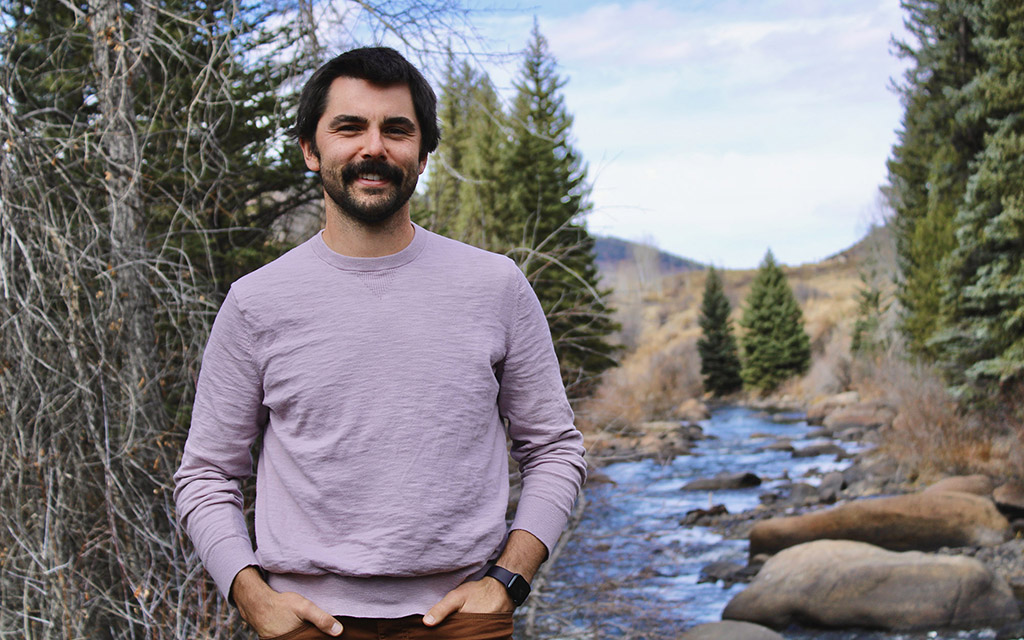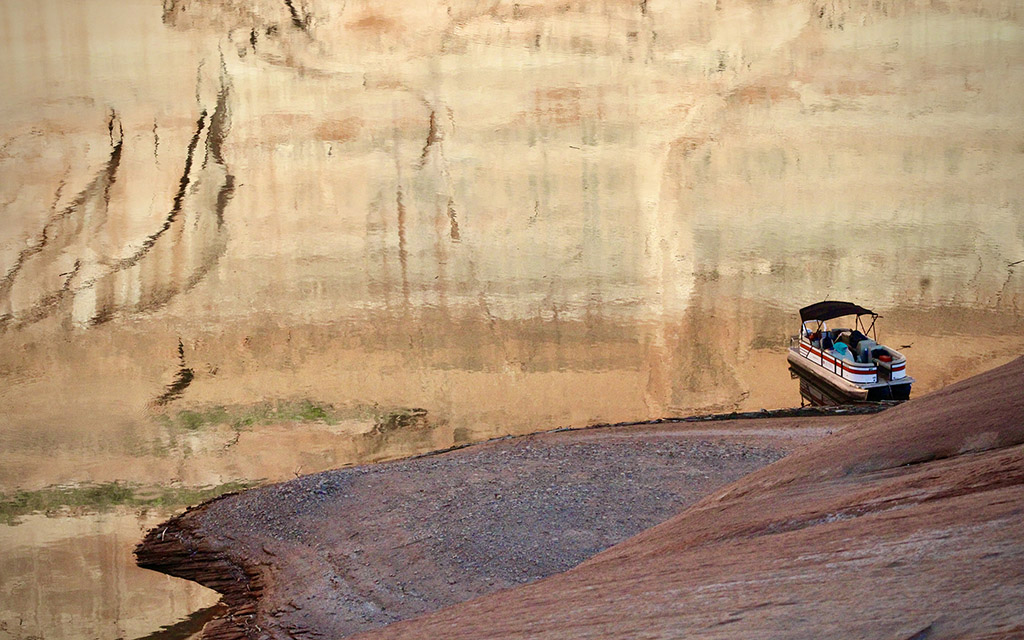
The Colorado River flows through Eagle County, Colorado, in March 2019. Snow in the Rockies provides the largest share of the river’s water, which tens of millions of people across the Southwest rely on. (Photo by Mitch Tobin/The Water Desk)

James Dilzell, director of the Eagle River Watershed Council, by the river on Oct. 24, 2023. Water flows from here to cities and farms as far south as Arizona, California and Mexico. “We’re all in this together and it’s all the same water,” Dilzell said. (Photo by Alex Hager/KUNC)

A pontoon boat is tied up on a recently revealed beach in one of Lake Powell’s side canyons on April 10, 2023. The evening sunlight casts a reflection of the canyons “bathtub rings” on the still water. (Photo by Alex Hager/KUNC)
When the snows come to the mountains of Colorado, it’s good news for skiers but also the first step to recharging the Colorado River.
But this winter’s precipitation outlook is unclear, and how it unfolds will have an outsized impact on the next few years of management of the river, which supplies water to tens of millions of people from Wyoming to Mexico and gets most of that water from high-altitude snow, two-thirds of which falls in Colorado.
A wet winter last year created more space for long-term negotiations about how to share river, but policy analysts say things could quickly turn in the wrong direction if snowfall is low in the coming months.
“Rivers are a great example of how we’re all connected,” said James Dilzell, director of the nonprofit Eagle River Watershed Council, as he stood on the banks of Homestake Creek in Eagle County, Colorado, this fall. “It’s not a totally separate place to be here in the headwaters in Eagle County versus somewhere in Utah or Phoenix. We’re all in this together, and it’s all the same water.
“It’s amazing to think of the journey,” he said, noting that what happens to the rivers and streams near the resort town of Vail has far-reaching impacts.
The Eagle River watershed, mostly comprised of tranquil mountain creeks that surge with spring snowmelt, contributes about 3% of all the Colorado River’s water. Soon, feet of snow should blow into Eagle County valleys and wetlands, giving water managers a clearer picture of how the river and the seven states that use it – Arizona, Colorado, California, Nevada, Utah, New Mexico – will fare in the near future.
But right now, that picture is far from clear.
‘It’s a big crapshoot’
Even in an age with complex forecasting methods and a sprawling network of weather data sensors, accurate predictions for a winter’s worth of snow are hard to come by.
“I can tell you that it’s anyone’s guess,” said Becky Bolinger, Colorado’s assistant state climatologist. “At the very beginning of the water year, it’s a big crapshoot. We don’t have a lot to go on.”
Winter weather in the Colorado River Basin this year will be largely dictated by El Niño – a phenomenon where warmer-than-usual water in the Pacific Ocean changes temperature and precipitation patterns over the Western U.S.
Typically, El Niño brings warmer, drier weather to northern parts of the West, and cooler, wetter weather to southern parts. Frustratingly for forecasters in the Colorado River Basin, the dividing line between those weather patterns falls in and around Colorado.

An early season forecast showed the Colorado River Basin just as likely to get a dry winter as a snowy one, although the likelihood of snow edged up slightly in later forecasts. (Map courtesy National Weather Service)
In October, the three-month forecast from the National Weather Service’s Climate Prediction Center showed the entire Colorado River Basin equally likely to have above, below or near average precipitation for November, December and January. By November, the outlook for January, February and March was calling for slightly above-average precipitation for most of the Rocky Mountains.
How much of that water ends up in reservoirs will not come into focus until January, though decisive data isn’t typically available until late May or early June, when streamflows reach their peak.
Forecasters do know one thing for certain: Last winter’s heavy snows left an impact. Snow totals broke records in Colorado, soaking the ground and setting up good conditions for runoff in spring 2024. That’s because dry ground acts like a sponge, soaking up and holding on to precipitation.
But a snowy winter and rainy summer like the last help fill up that sponge, making it easier for the spring melt to run off into streams, rivers and reservoirs. So this winter’s snow is less likely to get lost on its way to the river.
“Even though we’re kind of at the beginning of the race, we’re not starting further back from the starting line than we should,” Bolinger said.
Watching snow from the desert
As the Colorado River has been stretched by drought and rising demand, soil moisture data has come under greater scrutiny, as water managers look for increasingly granular, precise data about water availability.
Data about snow, soil and streamflow is important far from the mountains.
Phoenix, for example, is hundreds of miles from the Rockies, gets 40% of its water from the Colorado River. So the city’s water managers track Colorado weather closely.
“We watch it throughout the winter,” said Cynthia Campbell, a water adviser for Phoenix. “October 1 comes around and it’s game on. We watch the snow patterns, we cheer when there’s big snowfall in the Rockies.”
Water managers in other major cities like Los Angeles, San Diego, Las Vegas and Albuquerque also keep a close eye on that faraway snow and how it affects the nation’s two largest reservoirs, Lake Powell and Lake Mead.

The Central Arizona Project canal flows through Phoenix in this January 2019 photo. The city gets about 40% of its water from the Colorado River, and water managers must keep a close eye on snow data from the Rockies to understand local water availability. (Photo by Ted Wood/The Water Desk)
Powell’s levels are largely dependent on precipitation from the past few winters. Lately, they’ve dropped to record lows, imperiling a major dam and hydropower system. Lake Mead, which stores water for use in Phoenix and other Southwestern cities, has also hit record lows after more than two decades of drought and steady demand. With both major reservoirs on the brink, each winter has become more important.
“We have, even over the past decade or two, really seen how this system can seemingly turn on a dime,” Campbell said. “Especially when it’s at lower levels.”
‘We can’t be naive’
In recent years, water managers throughout the Southwest have been operating in a kind of emergency mode, assembling a patchwork of temporary conservation deals to keep water in Lake Powell and Lake Mead and stave off damage to major dams.
But even under intense federal pressure, the seven states that rely on the Colorado River have not been able to agree on longer-term guidelines that would substantially cut back demand. River experts say last winter’s boost lifted some weight off negotiators’ shoulders, letting them finally focus on the long term.
Arizona, California and Nevada say their recent short-term conservation deal has eased some of the pressure, but policy analysts say a wet 2023 did most of the heavy lifting there. Talks are underway to shape a new set of guidelines for how the river is shared before the current rules expire in 2026.

Snow-capped mountains reflect off a portion of Homestake Creek in Eagle County, Colo.rado, on Oct. 24, 2023. This winter, the valley should be buried in snow that will go on to help recharge the Colorado River. (Photo by Alex Hager/KUNC)
Kyle Roerink, director of the nonprofit Great Basin Water Network, said last year’s wet winter could allow for those long-term talks, but warns that the perilous state of Lakes Powell and Mead means dry winters could again force new short-term conservation deals.
“Two or three dry years will bring us back to the brink,” he said. “There’s no doubt about it. So we can’t be naive. We can’t take our foot off the gas.”
Negotiators face an uphill battle to agree on new guidelines that work for everyone, including the 30 federally recognized tribes that use the river’s water and have called for a greater voice in shaping its future. Big cities, farms, conservationists, the federal government and outdoor groups are also advocating for policies that protect their interests.
At the center of the talks is the need to reduce demand on the Colorado River at a time when climate change is steadily reducing supply. Roerink said that will take forward thinking.
“I am just hoping, praying, crossing my fingers that decision makers on the inside this time will not take the easy route,” he said. “They’re going to do the hard work, and we’re going to have better long-term outcomes to avoid being where we were the past couple of years.”
-This story is part of ongoing coverage of the Colorado River, produced by KUNC and supported by the Walton Family Foundation.